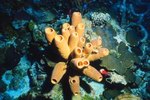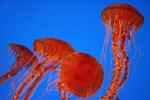
Sandworms are segmented marine worms found on both sides of the North Atlantic. Sometimes called jaw worms, they belong to the phylum Gnathostomula, stemming from the Greek words gnathos, meaning jaw, and stoma, meaning mouth. Sandworms are popular bait worms, living in the sand under shallow waters along the coast.
They Administer a Painful Bite
Sandworms are long, slender and slightly flattened. Two sharp hooks, or jaws, each having up to 10 teeth, deliver a painful bite. Sandworms have more than 200 segments, with four pair of slender tentacles reaching to the ninth segment, and two pairs of eyes. They breathe through the thin skin of bristled, paddle-shaped appendages called parapodium. Sandworms use their parapodium, located along their sides, for swimming and burrowing. Some species grow up to 35 inches long and 1 1/2 inches wide.
Living in Mucus-Lined Burrows
Found along the West Coast from Alaska to Central California, and on the East Coast, south to Virginia, sandworms live in mucus-lined burrows in the sand and sediment above the low tide marks of bays and inlets. They're also found along Europe's North Atlantic Coast, south to France and the North Pacific Coast in the Bering Sea and off Japan.
Food is Ground in Their Gizzard
Sandworms are omnivores, and their diet consists of small invertebrates and organic matter. Food passes through their esophagus, found in segments 6 through 14, and is temporarily stored in their crop, in segments 15 and 16. Moving to the gizzard, it's ground with ingested sand. Passing into the intestine, nutrients are absorbed into the sandworms' blood and fecal matter is evacuated through the anus, located in the last two segments. The coelom is a fluid-filled space under their skin that surrounds the digestive tract.
Mating Means Death for Mature Males
Females, identified by their iridescent dull green color, don't swim; fertilization takes place in their burrows. They lay between 50,000 and 1.3 million fertilized eggs onto the sediment's surface. Adult males are iridescent bright blue, fading to green. During the new moon, males swarm into the water, becoming easy prey. Twelve days after fertilization, larvae hatch on the water's bottom. Juveniles are swimming by 16 weeks old. Most sandworms reach maturity in two to three years.
References
Photo Credits
-
John Foxx/Stockbyte/Getty Images
Writer Bio
Karen Mihaylo has been a writer since 2009. She has been a professional dog groomer since 1982 and is certified in canine massage therapy. Mihaylo holds an associate degree in human services from Delaware Technical and Community College.



